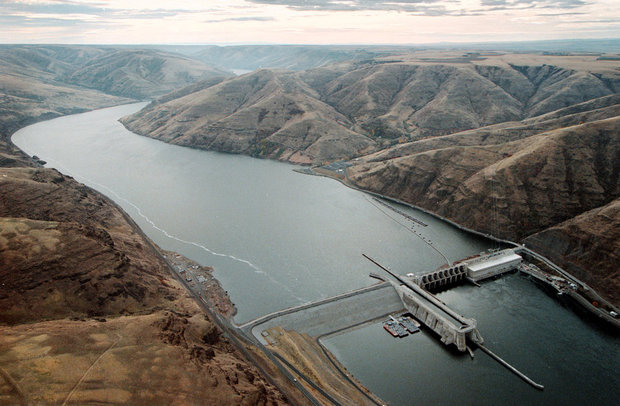forum
library
tutorial
contact

Breaching Proposal
Could Come in Stages
by Eric Barker
Moscow-Pullman Daily News, March 21, 2021
|
the film forum library tutorial contact |

|
Breaching Proposal
by Eric Barker
|
Rep. Mike Simpson says if money is OK’d for his dam plan,
the implementation could be spelled out in subsequent bills
 Rep. Mike Simpson said legislation for his sweeping plan to save salmon and steelhead by breaching the four lower Snake River Dams could come in multiple phases.
Rep. Mike Simpson said legislation for his sweeping plan to save salmon and steelhead by breaching the four lower Snake River Dams could come in multiple phases.
Under that scenario, placeholder funding for the $33 billion proposal would be inserted into a massive infrastructure bill expected to be considered later this year, while more complicated legislation detailing how the money is to be spent would rely on future congressional action.
The two-phase approach would allow Simpson, R-Idaho, more time to win support for the controversial plan and time to craft complex legislative language implementing the idea that not only pays for breaching but also mitigation for affected communities and industries.
He said writing the language is likely to be "a nightmare because it is so encompassing," but pledged it would be released to the public for review.
"In the meantime, we would like to get the funding for this -- even if we don't have the legislation done -- set aside in an infrastructure bill. Then if nothing ever develops from it, you could release the money to be used other places," he said while speaking to the Boise City Club on Tuesday afternoon via the internet application Zoom. "But we would like that money set aside in the infrastructure bill. That looks like our best shot of getting the funding. If we don't get it there, it's not the last opportunity, but that seems like the best one."
Simpson unveiled his concept last month. On Tuesday, he detailed the plan to the City Club, a nonprofit, nonpartisan organization designed to foster community dialogue on important issues.
He explained his motivation -- to save the fish for future generations of Idahoans and to provide citizens of the Pacific Northwest certainty and security by ending what he calls the "salmon wars." His proposal would stabilize the legal standing of other hydroelectric dams in the region and the finances of the Bonneville Power Administration that markets power generated at federal dams on the Columbia and Snake rivers.
Simpson argued there is a threat to dismissing his concept and instead opting to stick with the status quo. He believes because of the strength of environmental laws like the Endangered Species Act, the dams will be breached someday and waiting could mean it will happen without the mitigation he is proposing. That mitigation includes billions to replace hydropower produced at the dams, alternative crop transportation for farmers, cleaning water throughout the Columbia Basin and economic help for communities like Lewiston.
He referenced timber communities in western Oregon and dam backers on the Klamath River as cautionary tales. For years, the timber industry fought logging restrictions meant to help threatened spotted owls, only to eventually see mills shuttered by mandated owl-friendly logging reductions. Congress recently rejected a plan to remove dams on the Klamath River that included mitigation for farmers, fishermen and Native American tribes. Now the dams are coming out anyway.
The same will happen on the Snake, he said.
"Eventually they will come out. The Endangered Species Act trumps almost everything. I don't know of a time we have been able to defeat the Endangered Species Act or even if we should defeat the Endangered Species Act," he said. "It trumps things because when you are talking about an endangered species, once it goes extinct there is no way you can bring it back, only God can do that."
Asked about provisions of his concept that would help Lewiston and Clarkston, Simpson spoke about his proposal for a $1.25 billion Snake River Center For Advanced Energy Storage, which would include a $275 million battery research campus in the Lewiston-Clarkston Valley.
"I think we can expand their economy into different arenas, or give them the opportunity to do that, that would be beneficial for them in the long run," he said. "This is a chance that I think would be a mistake for them to pass up."
Simpson said Idaho has much more at stake than its neighbors. The dams, which are in eastern Washington, provide most of their benefits to the Evergreen State, he said, while Idaho incurs high costs to keep them in place.
"It's the salmon runs that come to Idaho that are going to go extinct, that cost is borne by us. The benefits go to the state of Washington frankly. You know how much power we get out of the dams? About 8 percent of that comes to Idaho. We get cheaper barging transportation (but) we can get around that; we can make transportation cheaper for shippers," he said. "Does it seem right to you that Idaho pays the costs of the dams and the benefits go somewhere else? That just doesn't make sense to me."
Simpson's talk may be viewed at bit.ly/3cfRHMZ.
learn more on topics covered in the film
see the video
read the script
learn the songs
discussion forum
